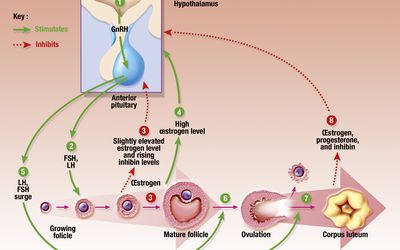Luteal Phase of the Menstrual Cycle

Luteal Phase of the Menstrual Cycle
More in Menstrual Disorders
The luteal phase of the menstrual cycle begins after ovulation occurs on Day 14 and continues until the first day of your period (Day 1). It is also known as the premenstrual phase or the ovulatory phase.
On average, the luteal phase lasts from 10 to 14 days. If the luteal phase is less than 10 days, this may indicate a fertility problem, sometimes referred to as a luteal phase defect.
What Happens During the Luteal Phase
Ovulation is a process that begins when the level of luteinizing hormone or LH surges, and ends 16 to 32 hours later with the release of an egg from the ovary. During ovulation, the ovaries release a single egg from only one of the two ovaries each menstrual cycle. Luteinizing hormone triggers enzymes to break down the wall of the follicle to release the egg. Then it stimulates the follicle to form the corpus luteum and produce progesterone.
During the luteal phase, estrogen and progesterone increase and work together to create changes in the lining of the uterus that prepare it to accept an embryo, should conception occur. The lining thickens so that it will be in the right condition for implantation and nourishment of a fertilized egg. Fertilization happens in the fallopian tubes, and the timing of the thickening of the uterine walls must coincide with the arrival of the fertilized egg, which can take a few days after ovulation.
If implantation does not occur, estrogen and progesterone levels decline and the lining of the uterus, called the endometrial lining, begins to be shed. This then leads to menstruation. The luteal phase ends when menstruation begins. That marks Day 1 of your next menstrual cycle.
The Relationship Between Luteal Phase Defects and Miscarriages
A luteal phase defect (also called a luteal phase dysfunction or luteal phase deficiency) refers to a problem with the luteal phase, with the result being that the uterine lining might not be optimally prepared for implantation of a fertilized egg.
However, the luteal phase defect is only a theoretical cause of infertility or miscarriage. The idea underlying this theory is that if the uterus is not fully prepared to support a pregnancy, then either a woman will not get pregnant at all or the pregnancy will not implant properly and will ultimately miscarry.
How Many Phases Are There During the Menstrual Cycle?
There are just two menstrual cycle phases that occur during every monthly cycle. The first phase is the follicular phase or the proliferative phase. The follicular phase begins on Day 1 of the menstrual cycle when estrogen and progesterone levels are at their lowest.
During this phase, the uterine lining, or endometrial lining, is shed through menstruation and then begins a period of regrowth and thickening in preparation for an embryo should conception occur. This follicular phase lasts about 10 to 14 days, or until ovulation occurs, after which you pass into the luteal phase.
A Word From Verywell
Your menstrual cycle is guided by a complex interplay of hormones which nature developed to support the pregnancy. Get to know what is happening at each phase so you can understand the normal functioning of your body.
Source: https://www.verywellhealth.com/luteal-phase-of-the-menstrual-cycle-3522712